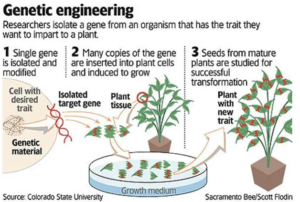Centre says opposition to GM crops based on unfounded fears
Why in News?
Recently, the Centre has pointed out to the SC that India is already importing and consuming oil derived from Genetically Modified (GM) crops in a plea challenging the clearance for the environmental release of GM mustard.
- Also, around 9.5 million tonnes (mt) of GM cotton seed is produced annually and 1.2 mt of GM cotton oil is consumed by human beings, and about 6.5 mt of cotton seed is consumed as animal feed.
- Reason of Import: The Ministry of Environment and Forests (MoEF) had submitted that the average prices of refined palm oil, soy oil, and mustard oil are increasing continuously and India needs to be independent in oil production to meet the domestic consumption demand.
What is the State of the Edible Oil Sector in India?
- Place in Country’s Economy:
- India is one of the largest producers of oilseeds in the world.
- The oil sector occupies an important position in the agricultural economy.
- It accounts for the estimated production of 36.56 mt of nine cultivated oilseeds during the year 2020-21 as per the data released by the Ministry of Agriculture.
- India is the world’s second-largest consumer and number one importer of vegetable oil.
- The present rate of edible oil consumption in India surpasses the domestic production rate. Hence, the country has to rely on imports to meet the gap between demand and supply.
- At present, India meets nearly 55% to 60% of its edible oil demand through imports. Therefore, India needs to be independent in oil production to meet the domestic consumption demand.
- Palm oil (Crude + Refined) constitutes roughly around 62% of the total edible oils imported and is imported mainly from Indonesia and Malaysia, while Soyabean oil (22%) is imported from Argentina and Brazil and Sunflower oil (15%) is imported mainly from Ukraine and Russia.
- Types of Oils Commonly Used in India:
- In India, groundnut, mustard, rapeseed, sesame, safflower, linseed, niger seed, and castor are the major traditionally cultivated oilseeds.
- Soybean and sunflower have also assumed importance in recent years.
- Coconut is the most important among the plantation crops.
- Among the non-conventional oils, rice bran oil and cottonseed oil are the most important.
- Export-Import Policy on Edible Oils:
- Import of edible oils is under Open General License (OGL).
- In order to harmonize the interests of farmers, processors, and consumers, Government reviews the duty structure of edible oils from time to time.
What are the Related Government Initiatives?
- The government of India launched National Mission on Edible Oils-Oil Palm as a centrally-sponsored scheme, being implemented jointly by the central and state governments with a special focus on the northeast region and the Andaman and Nicobar Islands.
- It is proposed to have an additional 6.5 lakh hectares for palm oil by 2025-26.
- In order to improve and systemize the data management system in the vegetable oil sector, the Directorate of Sugar & Vegetable Oils under the Department of Food and Public Distribution has developed a web-based platform (veg oils.nic.in) for online submission of inputs by vegetable oil producers on monthly basis.
- The portal also provides a window for online registration and submission of monthly production returns.
UPSC Civil Services Examination, Previous Year Questions (PYQ) Prelims
Q1. Consider the following statements: (2018)
- The quantity of imported edible oils is more than the domestic production of edible oils in the last five years.
- The Government does not impose any customs duty on all imported edible oils as a special case.
Which of the statements given above is/are correct?
(a) 1 only
(b) 2 only
(c) Both 1 and 2
(d) Neither 1 nor 2
Ans: (a)
Q2. Other than resistance to pests, what are the prospects for which genetically engineered plants have been created? (2012)
- To enable them to withstand drought
- To increase the nutritive value of the produce
- To enable them to grow and do photosynthesis in spaceships and space stations
- To increase their shelf life
Select the correct answer using the codes given below:
(a) 1 and 2 only
(b) 3 and 4 only
(c) 1, 2, and 4 only
(d) 1, 2, 3 and 4
Ans: (c)
Q3. Bollgard I and Bollgard II technologies are mentioned in the context of (2021)
(a) clonal propagation of crop plants
(b) developing genetically modified crop plants
(c) production of plant growth substances
(d) production of biofertilizers
Ans: (b)
Mains
- How can biotechnology help to improve the living standards of farmers? (2019)




